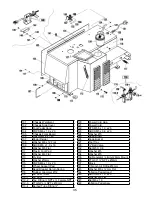
21
ALLOY WHEELS-
Some manufacturers offer wheels with little or no drop
center. These are not DOT approved. The tire or wheel - or
both - can be damaged and the tire could explode under
pressure, resulting in serious injury or death. If you attempt
to mount/demount this type of wheel, use extreme caution.
(See Fig 12.1)
EUROPEAN PERFORMANCE WHEELS
(ASYMMETRICAL HUMP)-
Some European wheels have very large humps except
near the valve hole. On these wheels, the beads should be
loosened at the valve hole on both the upper and lower
sides first.
WHEELS WITH TIRE PRESSURE WARNING
SENSORS-
Performance wheels on some vehicles have a pres-
sure sensor strapped to the rim opposight the valve hole
or mounted on the valve stem. On these wheels, the beads
should be loosened at the valve hole on both upper and
lower sides first. (See Fig 12.2)
DEMOuNTINg TuBE TYPE TIRES
1. After both tire beads are loosened, lubricate the beads
and rim liberally.
2. Position the demount head and bead lifting tool as
described earlier paying careful attention not to pinch the
tube. Depress the table top pedal and rotate only a short
distance at a time. This allows you to stop the process
should you suspect the tube is getting pinched.
3. After upper bead is demounted, remove tube and
demount lower bead.
SECTION 13
MOuNTINg
1. Inspect the wheel closely for damage. Clean the wheel
and remove any light corrosion or rubber residue. Do not
attempt to service heavily corroded wheels. (See Fig 13.1)
2. Inspect tire for damage, paying close attention to the
beads. Verify size match between tire and wheel. (See Fig
13.2)
3. Lubricate both tire beads liberally with tire manufacturer’s
approved lubricant. (See Fig 13.3)
Fig 12.2
REMEMBER:
TABLE TOP ROTATION CAN BE STOPPED AT ANY
TIME BY REMOVING YOUR FOOT FROM THE ROTA-
TION PEDAL. NORMAL TABLE TOP ROTATION
FOR DEMOUNTING IS CLOCKWISE. DEPRESS THE
TABLE TOP PEDAL TO ROTATE THIS DIRECTION.
TO ROTATE THE TABLE TOP COUNTERCLOCKWISE,
LIFT THE PEDAL UP WITH YOUR TOE.
Fig 12.1
Fig 13.1
Fig 13.3
Fig 13.2
wARNINg!
THE RIM AND BEAD MUST BE LIBERALLY
LUBRICATED. FAILURE TO USE AN ADEqUATE
LUBRICANT CAN LEAD TO THE BEAD BINDING ON
THE RIM AND LEAD TO DAMAGE TO THE MOTOR
AND OR VOID THE WARRANTY.
Summary of Contents for R30XLT
Page 34: ...34 ...
Page 38: ...38 ...
Page 43: ...43 ...
Page 45: ...45 ...
Page 46: ...46 RECORD ALL MAINTENANCE NOTES AND SERVICE HISTORY HERE ...
Page 47: ...47 TIRE AND WHEEL DATA ...




































